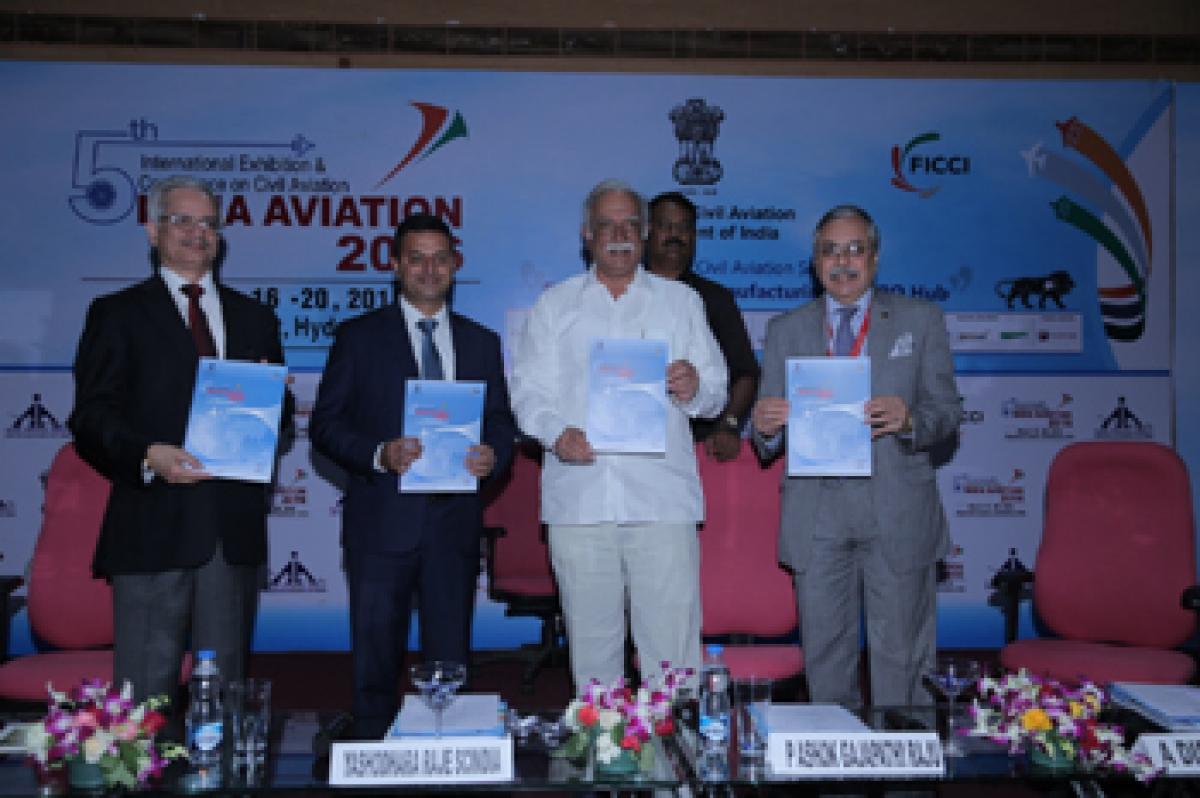Live
- Govt plans to establish offshore Johns Hopkins University Campus in India
- Goa Aces clinch Indian Racing League title
- Study finds how hormone therapy can reshape the skeleton
- High-street fashion players looking at India for manufacturing: Report
- Shreyas Iyer to lead Mumbai as Prithvi Shaw returns for Syed Mushtaq Ali Trophy
- 'Failed to resolve crisis': NPP withdraws support from BJP govt in Manipur
- Chennai: Actress Kasturi Remanded in Custody Until 29th of This Month
- Aaqib Javed likely to become Pakistan's new white-ball head coach
- BJP panel to draft poll charge sheet against AAP govt in Delhi
- Allu Arjun Thanks Fans in Patna, Teases 'Pushpa 2' Release
Just In

India is well on course to emerge as world’s third largest civil aviation market by the year 2020, a report brought out jointly by industry body Ficci and KPMG has revealed on Thursday.
A Ficci-KPMG report says rising disposable income levels, low fuel prices will drive growth
Hyderabad: India is well on course to emerge as world’s third largest civil aviation market by the year 2020, a report brought out jointly by industry body Ficci and KPMG has revealed on Thursday.
The report titled FICCI-KPMG 'India Aviation Report 2016 further maintained that the exponential growth of civil aviation sector in India would be driven by a diverse range of factors such as increasing disposable incomes, fall in prices of aviation fuel, spurt in tourism, visa reforms, etc., which placed India in a unique position.
In India, the domestic passengers grew by 20.6 per cent, the highest growth rate recorded in the world, to reach 138.8 million mark during the period from April 2015 to January 2016. International passengers grew by 7.6 per cent to 45.4 million during the same period.
Annual air passenger traffic is expected to reach around 370 million by 2020, with domestic traffic constituting around 80 per cent of the total. With that kind of growth, India is expected to move closer to achieving its vision of becoming the largest aviation market by 2030.
Union Civil Aviation Minister P Ashok Gajapathi Raju had formally released the report at an event on the second day of India Aviation 2016 show here on Thursday. Speaking on the occasion, the Minister said that increasing competition among states for aviation pie would further drive the growth of the key sector.
According to the report, the Indian civil aviation industry has exhibited tremendous resilience to the global economic slowdown and ranks ninth in the global civil aviation market. This is attributed largely to the growing economy, increased competition among airlines, especially among low cost carriers, modern airports, greater use of technology, foreign direct investment (FDI) and increased emphasis on regional connectivity.
The report highlighted that the National Civil Aviation Policy (NCAP 2016), which is likely to be launched next month, would provide a significant fillip to the industry. The various fiscal and monetary incentives, liberal policies focused on ‘ease of doing business’ and enhanced push for regional and global connectivity are expected to play positive role in the growth of the sector.
Steps taken to revive and operationalise around 160 airports in India, if chosen carefully, will improve air connectivity to regional and remote areas. Public- Private Partnerships (PPP) in the sector will get substantial support from the state in terms of financing, concessional land allotment, tax holidays and other incentives, it added.
“Enormous growth in domestic passenger traffic, substantial strengthening through government initiatives, decrease in global crude oil prices and airlines showing profits indicates a significantly positive transformation for the Indian civil aviation market,” said Harshavardhan Neotia, President, FICCI.
The close partnership between the government and the industry in ongoing and future projects will further improve regional connectivity, he added.
According to Amber Dubey, Partner and India Head of Aerospace and Defence at KPMG, the positive impact of NCAP 2016, rise in disposable incomes and the fall in ATF prices are likely to help India leapfrog into the top three of the world.
“One hopes that the government can match domestic ATF prices with global levels for a three year experimental period. Growth of aviation and tourism can create a huge multiplier in terms of GDP growth and jobs,” he added. The report strongly suggested that in order to ensure high-geared growth, it would be imperative to broaden the base of domestic flyers through greater air connectivity in tier 2 and 3 cities.

© 2024 Hyderabad Media House Limited/The Hans India. All rights reserved. Powered by hocalwire.com







